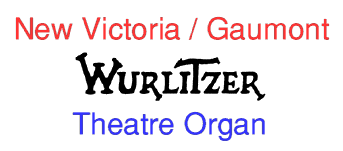

|
Quick Links to other sections on this page . . .
Introduction The Installation The result of this was that the best sounds were to be heard in the circle and balcony and the worst listening position was the front stalls. Because of this the organist struggled with a significant time lag as the reflected sound reached him reflected from the back of the theatre and at a reduced power level. The problem was overcome by amplifying the sound from the organ chambers and reproducing via the cinema speakers behind the screen so providing a more powerful and immediate sound. Organ Specification Wurlitzer Style 220SP with circular console. 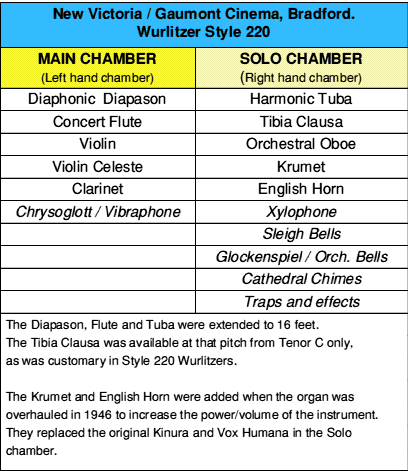 Note that the Krumet (from Wurlitzer UK stock) and English Horn (more of a trumpet and rather an 'alien' sound in the ensemble was made locally by Rodgers of Bramley) were added during an overhaul in 1946 and they replace the original Kinura and Vox Humana to give extra extra power to the volume which had previously been thought light for an auditorium of this size. Amplification was essential for audience participation sing-a-long. Experts in theatre organ installations were of the opinion that this Wurlitzer installation "was of excellent tone and particularly appealing when quality rather than quantity is the prime consideration". Flood Damage in Cinema For the record, the Ritz cinema in Broadway also suffered on the same morning with flooding to its entire stalls area and destroying beyond repair the Compton organ console which could not be raised in time. Thereafter the New Victoria/Gaumont remained the only city-centre cinema to have a working theatre pipe organ. Resident Organists 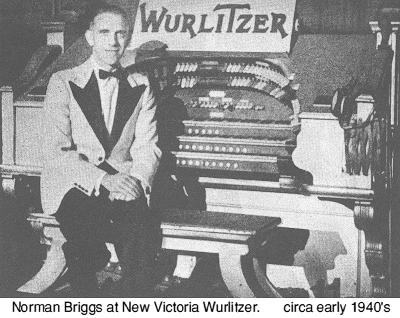 Another familiar name was that of Norman Briggs whose residency lasted ten years from 1939 to 1949. Norman Briggs LRAM started as an orchestral pianist in various local silent cinemas. At the age of 18 (in 1927) he was pianist and assistant organist at St George's Hall. In 1934 he became organist and stage pianist with Sydney Phasey and His Orchestra at the New Victoria and in 1939 he became the resident organist giving many broadcasts on the Wurlitzer and others on the BBC theatre organ. The BBC, incidentally, had permanent cabling installed in the New Victoria in anticipation of the many broadcasts to be made from there. Briggs became a household name during the war. He also held the post of City of Bradford Organist and played the Holt Concert Organ at the nearby St George's Hall and occasionally the 3-manual Compton organ in the Ritz cinema in Broadway. Charles Randolph followed at the New Victoria as house organist. During 1949 there were many 'guest weeks' with organists such as . . . In 1946 Arnold Loxam was appointed deputy organist playing every Sunday and deputised for Norman Briggs until 1948. From December 1948 Arnold also played full weeks or odd days as well as Sundays until 1962 and was famous for his bouncey style. The prospect of a regular house organist at the (now) Gaumont was looking a bit bleak in the mid 1960's when along came two young organists who each found fame on this Wurlitzer. One was David Hamilton who played at weekends and made an LP record of the sounds of this fine instrument. Another local young organist, David Lowe, quickly made a name for himself on this organ with his regular solo spots. The natural sound of the Bradford Wurlitzer without amplification was a delight to the ears with the giant dome adding to the richness of the sound. From around 1962 onwards David Hamilton played as required. From May 1965 to October 1967 David Lowe played every Sunday plus full weeks and special evenings as required. David also played for the Saturday morning childrens shows when these were transferred from the original Odeon in Manchester Road. 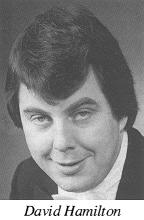
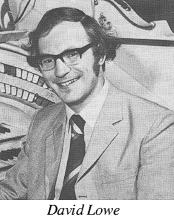 Geoff Stephenson, who also played at the Odeon in Rotherham, and Frank Steele deputised for David Lowe during this period as required. From November 1967 to the closure in 1968, David Hamilton and Geoff Stephenson played as required. The last resident organist to play the Wurlitzer was Geoff Stephenson and he also made the last ever broadcast of the organ by the BBC on Thursday 2nd May, 1968. Arnold Loxam, now a sprightly octogenarian and made an honorary Doctor of Music by Bradford University, along with David Lowe are both still (in 2004) very active on the organ concert circuit and each have made several cassettes and CDs on other organs and their notable performances both in the UK and abroad can be heard regularly on BBC radio. Organ Concerts Sunday 18th December 1938 at 7.45pm. The organ was always an important feature of the annual Cinderella Club children's concert at Christmas. Recording Sessions The first session on the morning of Friday 5th August 1966 in the empty cinema and with David Lowe, the then house organist who also had a residency playing a 2-manual Hammond C3 at the Silver Blades Ice Rink in nearby LIttle Horton Lane. At the Ice Rink David played strict tempo music for the ice dancing and this was to be the theme for the Wurlitzer recording. It was believed to be the first time that a stereo recording of a Wurlitzer pipe organ being played in strict tempo and with the acoustic ambience of the huge empty Gaumont auditorium. The result was a rich lush sound and the nearest Bradford ice dancers would ever get to the live Wurlitzer sounds enjoyed by American skaters where pipe organs were installed in some ice stadiums. The second recording session at the request of the late David Hamilton took place during the night of Sunday 19th May 1968 after the evening film performance had finished. This session was an attempt to capture in stereo the fine quality of sound probably for the last time as the Gaumont was to close six months later for twinning conversion. Hamilton had previously been a house organist at the Gaumont whilst he (like David Lowe) was a resident organist at the Ice Rink. For the recording David Hamilton's repertoire was chosen to demonstrate the wide potential of this installation. For both recording sessions, the open reel tape recorder(s) and mixer were set up in the rear stalls. A pair of uni-directional microphones were positioned in the front circle and focused onto the left and right chambers above the proscenium. For the David Hamilton recording a third microphone mounted in a parabolic reflector was placed in the front of the balcony and focused on the right hand solo chamber and its output mixed in with the stereo pair in order to add clarity to the higher frequencies which might otherwise have been muffled by the auditorium acoustics. The result was considered successful and the time/phase differences of the sounds so recorded took on a new dimension when re-played through quadraphonic surround sound equipment of that era. A/B monitoring was via headphones and all tape editing done afterwards. Ventilation fans and anything else that might interfere were temporarily switched off. Now over 35 years on the tapes still sound quite stunning and a wonderful 'record' of the Wurlitzer. Closure and Removal of Organ Reference Sources and Acknowledgements May not be copied or reproduced without permission.
|